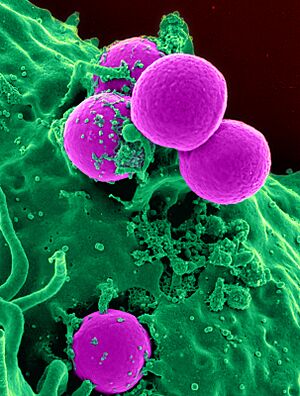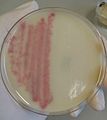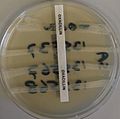MRSA facts for kids


MRSA stands for Methicillin-Resistant Staphylococcus Aureus. It's a type of germ, or bacterium, that can cause infections in people. MRSA is a bit tricky because it's strong. It has learned to fight off many common antibiotic medicines. This makes it harder to treat than other germs.
MRSA is resistant to medicines like penicillin and cephalosporin. This means these antibiotics don't work against it anymore.
The signs of an MRSA infection depend on where it is in the body. Most often, it causes small skin infections. These can look like pimples, boils, or areas with pus. Sometimes, MRSA can cause more serious problems. It might infect surgical wounds, the lungs, or even the blood.
While many MRSA infections are not very serious, some can be dangerous. Health experts are worried about how easily these tough MRSA germs spread. Because it's hard to treat, MRSA is sometimes called a "super bug."
What Causes MRSA Infections?
Common staph germs are found everywhere. They often live on our bodies without causing any harm. About 25-30% of people have staph bacteria in their noses. They don't even know it!
But staph can cause problems if it gets inside the body. This often happens through a cut or a scrape. Once inside, the staph can cause an infection. Staph is a common reason for skin infections. Usually, these are minor and get better on their own.
Sometimes, staph can cause more serious issues. These include infected wounds or a lung infection called pneumonia.
How MRSA Became Resistant
Normally, doctors treat staph infections with antibiotics. But over many years, some staph germs have changed. They have become resistant to antibiotics. This means the medicines that used to kill them don't work anymore.
MRSA was first found in 1961. It's now resistant to many common antibiotics. These include methicillin, amoxicillin, penicillin, and oxacillin.
Some antibiotics still work against MRSA. But these germs are always changing and adapting. Scientists are working hard to create new medicines. It's a tough race to keep up with these "super bugs."
Images for kids
See also
 In Spanish: Staphylococcus aureus resistente a la meticilina para niños
In Spanish: Staphylococcus aureus resistente a la meticilina para niños




